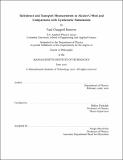| dc.contributor.advisor | Miklos Porkolab. | en_US |
| dc.contributor.author | Ennever, Paul Chappell | en_US |
| dc.contributor.other | Massachusetts Institute of Technology. Department of Physics. | en_US |
| dc.date.accessioned | 2016-09-30T18:24:35Z | |
| dc.date.available | 2016-09-30T18:24:35Z | |
| dc.date.copyright | 2016 | en_US |
| dc.date.issued | 2016 | en_US |
| dc.identifier.uri | http://hdl.handle.net/1721.1/104458 | |
| dc.description | Thesis: Ph. D., Massachusetts Institute of Technology, Department of Physics, 2016. | en_US |
| dc.description | This electronic version was submitted by the student author. The certified thesis is available in the Institute Archives and Special Collections. | en_US |
| dc.description | Cataloged from student-submitted PDF version of thesis. | en_US |
| dc.description | Includes bibliographical references. | en_US |
| dc.description.abstract | Turbulence in tokamak plasmas is the primary means by which energy is transported from the core of the plasma to the edge, where it is lost, and is therefore the main limitation of tokamak plasma performance. Dilution of the main-ion species was found to have a stabilizing effect on ion gyroradius scale turbulence in tokamak plasmas. Dilution of deuterium tokamak plasmas is the reduction of the ratio of the deuterium ion density to the electron density, nD=ne, to less than 1.0 through the introduction of low-Z impurity species into the plasma. Controlled dilution experiments were performed on Alcator C-Mod wherein plasmas at a range of electron density and plasma current were seeded with nitrogen while a cryopump held the electron density fixed. The electron density fluctuations due to turbulence were monitored using a phase contrast imaging (PCI) diagnostic, an absolutely calibrated diagnostic that measures the line-integral of the electron density fluctuations along 32 vertical chords. In these experiments the seeding reduced the PCI density fluctuations, and had a stabilizing effect on the ion energy transport. The seeding also reversed the direction of intrinsic rotation in certain cases. Nonlinear simulations using the gyrokinetic turbulence code GYRO were performed using measured kinetic profiles from the dilution experiments both before and after the nitrogen seeding. The GYRO simulations reproduced the observed reduction in the turbulent ion energy transport with the nitrogen seeding. The GYRO simulated turbulent density fluctuations were compared to the PCI measurements using a synthetic diagnostic, and they were found to be consistent. GYRO simulations were also performed varying only the main ion dilution to explore the theoretical effects of the dilution on energy transport. Through this it was found that the dilution reduced the turbulent ion energy transport in a wide variety of cases, but primarily increased the critical gradient at low densities, and primarily reduced the stiffness of the transport at high densities. This dilution effect is related to observations of reductions in energy transport from seeding on other tokamaks, and will likely have an impact on ITER and future fusion reactors. | en_US |
| dc.description.statementofresponsibility | by Paul Chappell Ennever. | en_US |
| dc.format.extent | 139 pages | en_US |
| dc.language.iso | eng | en_US |
| dc.publisher | Massachusetts Institute of Technology | en_US |
| dc.rights | M.I.T. theses are protected by copyright. They may be viewed from this source for any purpose, but reproduction or distribution in any format is prohibited without written permission. See provided URL for inquiries about permission. | en_US |
| dc.rights.uri | http://dspace.mit.edu/handle/1721.1/7582 | en_US |
| dc.subject | Physics. | en_US |
| dc.title | Turbulence and transport measurements in Alcator C-Mod and comparisons with Gyrokinetic simulations | en_US |
| dc.type | Thesis | en_US |
| dc.description.degree | Ph. D. | en_US |
| dc.contributor.department | Massachusetts Institute of Technology. Department of Physics | |
| dc.identifier.oclc | 958293579 | en_US |
